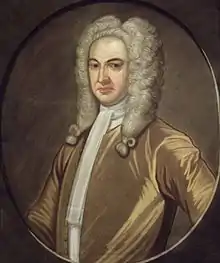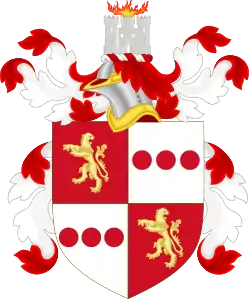Lewis Morris (speaker)
Lewis Morris Jr. (September 23, 1698 – July 3, 1762) was a colonial American judge, politician and vast landowner who was the 2nd Lord of the Manor of Morrisania.
Lewis Morris | |
|---|---|
.jpg.webp) | |
| Speaker of the New York General Assembly | |
| In office June 15, 1737 – October 20, 1738 | |
| Preceded by | Adolphus Philipse |
| Succeeded by | Adolphus Philipse |
| Member of the New York General Assembly | |
| In office 1732–1750 | |
| Personal details | |
| Born | September 3, 1698 Morrisania, Province of New York, British America |
| Died | July 7, 1762 (aged 63) Morrisania, Province of New York, British America |
| Spouse(s) | Catherine Staats
(died 1731)Sarah Gouverneur
(m. 1746; |
| Relations | Robert Hunter Morris (brother) James Graham (grandfather) |
| Children | Mary Morris Lawrence Lewis Morris Staats Long Morris Richard Morris Gouverneur Morris Euphemia Morris Ogden |
| Parents | Lewis Morris Isabella Graham Morris |
Early life

Morris was born on September 23, 1698 at Morrisania, his family's manor in the southwest section of today's Bronx. He was the eldest son of Lewis Morris (1671–1746) and Isabella (née Graham) Morris (1673–1752). His younger brother was Robert Hunter Morris, who served as the Deputy governor of New Jersey. His father was very prominent in public life and variously served as Chief Justice of New York and as the 8th Colonial Governor of New Jersey.[1]
His paternal grandparents were Sarah (née Pole) Morris and Richard Morris, who was originally from Monmouthshire, Wales. His grandparents bought Morrisania from Samuel Edsall in 1670 and moved there from Barbados. His mother was the eldest daughter of James Graham, who served as the first Speaker of the New York General Assembly and the first Recorder of New York City. Graham, who was born in Midlothian, Scotland, was a grandson of James Graham, 1st Marquess of Montrose.[2]
Career
Upon his father's death in 1746, he inherited the manor, becoming the 2nd Lord of the Manor of Morrisania which eventually became over 2,000 acres.[3] Lewis is considered "representative of those colonial-born politicians who came to dominate public life in eighteenth-century British America, during a time of frenetic colonial economic and demographic growth."[4]
Morris served as Judge of the High Court of the Admiralty of New York from 1738 until his death, with jurisdiction over New Jersey and Connecticut, and Judge of the Court of Oyer and Terminer. During his twenty-four year tenure as New York's vice-admiralty judge, he personally condemned more than 260 prize ships captured by colonial privateers, worth over £2 million.[4][5]
In 1722, he became a member of Governor William Burnet's council.[3] From 1732 to 1750, he represented Westchester County (which today is Westchester and Bronx counties) in the New York General Assembly.[6] He served alongside his father in the Assembly.[7] In 1737, was chosen to succeed Adolphus Philipse as Speaker of the New York General Assembly,[8] in which he served until 1738.[9] While speaker, he replaced virtually all of the judicial and militia officers in Westchester.[7]
Personal life
Morris was twice married. His first wife was Katrintje "Catherine" Staats (1697–1731), a daughter of New York surgeon, Dr. Samuel Staats.[10] Her paternal grandfather was Abraham Staats, one of the first settlers of the New Netherland colonies.[11] Together, they were the parents of:[12]
- Mary Morris (1723–1804), who married Thomas Lawrence, Esq., a son of Thomas Lawrence, mayor of Philadelphia.[13]
- Lewis Morris (1726–1798), a signer of the Declaration of Independence who married Mary Walton.[13][14]
- Staats Long Morris (1728–1800), a Loyalist who served as a Member of Parliament during the Revolutionary War who married Lady Catherine, Duchess of Gordon, widow of Cosmo Gordon, 3rd Duke of Gordon and daughter of William Gordon, 2nd Earl of Aberdeen, in 1756. After her death in 1779, he married Jane Urquhart (1749–1801) in 1780.[15][lower-alpha 1]
- Richard Morris (1730–1800), a prominent judge who married Sarah Ludlow in 1759.[17][18]
After his first wife died in 1731, he married Sarah Gouverneur (1714–1786), a daughter of Isaac Gouverneur and Sarah (née Staats) Gouverneur. Sarah was a niece of Speaker Abraham Gouverneur (who married Mary Leisler, daughter of Jacob Leisler and the widow of Jacob Milborne).[19] Together, they were the parents of:[20]
- Isabella Morris (c. 1746–1830), who in 1762 married Rev. Isaac Wilkins,[21] who represented Shelburne township in the Nova Scotia House of Assembly from 1785 to 1793. They were the parents of Lewis Morris Wilkins.[22][23]
- Gouverneur Morris (1752–1816), a U.S. Senator and U.S. Minister to France who married Anne Cary Randolph, a daughter of Thomas Mann Randolph of Virginia.[13]
- Euphemia Morris (1754–1818), who married Samuel Ogden, the brother Abraham Ogden, in 1775.[24][25]
After several years of declining health, Morris died at Morrisania on July 3, 1762. After his death, Governor Robert Monckton appointed his son Richard to his place on the New York Court of Vice-Admiralty.[4]
Gallery
 Portrait of his son, Lewis Morris, by John Wollaston
Portrait of his son, Lewis Morris, by John Wollaston.jpg.webp) Portrait of his son, Staats Long Morris, by John Wollaston
Portrait of his son, Staats Long Morris, by John Wollaston.jpg.webp) Portrait of his son, Gouverneur Morris, by Pierre Henri
Portrait of his son, Gouverneur Morris, by Pierre Henri Coat of Arms of the Morris family
Coat of Arms of the Morris family
References
- Notes
- Staats Long Morris (1728–1800) is likely the only American buried in Westminster Abbey. His grave is in the north aisle of the nave.[16]
- Sources
- "Lewis Morris, Judge and Chief Judge of NY Supreme Court of Judicature, 1715-1733". www.nycourts.gov. Historical Society of the New York Courts. Retrieved 25 September 2018.
- Senate, New York (State) Legislature (1901). Documents of the Senate of the State of New York. E. Croswell. p. 22. Retrieved 25 September 2018.
- "Lewis Morris (1698-1762)". www.nyhistory.org. New-York Historical Society. Retrieved 16 March 2020.
- Rhoden, Nancy L.; Steele, Ian K. (1999). The Human Tradition in Colonial America. Rowman & Littlefield Publishers. p. 195. ISBN 978-1-4616-4432-3. Retrieved 17 March 2020.
- Bonomi, Patricia U. (2015). A Factious People: Politics and Society in Colonial New York. Cornell University Press. p. 125. ISBN 978-0-8014-5533-9. Retrieved 17 March 2020.
- Hough, A.M., M.D., Franklin B. (1858). The New York Civil List: Containing The Names And Origin Of The Civil Divisions, And The Names And Dates Of Election Or Appointment Of The Principal State And County Officers From The Revolution To The Present Time. Albany: Weed, Parsons and Co. Retrieved 19 September 2018.CS1 maint: multiple names: authors list (link)
- Klein, Milton M. (2005). The Empire State: A History of New York. Cornell University Press. p. 192. ISBN 978-0-8014-8991-4. Retrieved 17 March 2020.
- Hutchins, Stephen C. (1880). Civil List and Constitutional History of the Colony and State of New York. Weed, Parsons & Company. p. 275. Retrieved 17 March 2020.
- Murlin, Edgar L. (1908). The New York Red Book. J. B. Lyon Company. pp. 356–365. Retrieved 22 September 2018.
- "MORRIS, Staats Long (1728-1800), of Huntly Lodge and Knaperna, Aberdeen". www.histparl.ac.uk. History of Parliament Online. Retrieved 17 March 2020.
- Bielinski, Stefan. "Abraham Staats". exhibitions.nysm.nysed.gov. New York State Museum. Retrieved 21 April 2017.
- The American Historical Magazine. The Publishing Society of New York. 1906. pp. 136–142, 429–430. Retrieved 16 May 2019.
- Reynolds, Cuyler; Cutter, William Richard (1914). Genealogical and Family History of Southern New York and the Hudson River Valley: A Record of the Achievements of Her People in the Making of a Commonwealth and the Building of a Nation | Vol. III. New York: Lewis Historical Publishing Company. Retrieved 20 January 2017.
- Revolution, Daughters of the American (1897). Lineage Book - National Society of the Daughters of the American Revolution. Daughters of the American Revolution. p. 8. Retrieved 17 March 2020.
- Burke, John (1838). A Genealogical and Heraldic History of the Commoners of Great Britain and Ireland Enjoying Territorial Possessions Or High Official Rank: But Uninvested with Heritable Honours. Colburn. p. 15. Retrieved 17 March 2020.
- "Staats Long Morris". www.westminster-abbey.org. Westminster Abbey. Retrieved 17 March 2020.
- "Richard Morris Family Bible"
- Genealogies of the State of New York: A Record of the Achievements of Her People in the Making of a Commonwealth and the Founding of a Nation. Lewis Historical Publishing Company. 1915. Retrieved 15 August 2017.
- Kirschke, James J. (2005). Gouverneur Morris: Author, Statesman, and Man of the World. Macmillan. ISBN 978-0-312-24195-7. Retrieved 17 March 2020.
- Reynolds, Cuyler (1914). Genealogical and Family History of Southern New York and the Hudson River Valley: A Record of the Achievements of Her People in the Making of a Commonwealth and the Building of a Nation. Lewis Historical Publishing Company. p. 1142. Retrieved 10 February 2019.
- York (State), New (1968). New York Marriages Previous to 1784. Genealogical Publishing Com. p. 459. ISBN 978-0-8063-0259-1. Retrieved 8 June 2020.
- Donovan, J. O. (1899). Biographical history of Westchester County, New York: Volume I. Dalcassian Publishing Company. p. 74. Retrieved 8 June 2020.
- Cook, Harry Tecumseh; Kaplan, Nathan Julius (1913). The Borough of the Bronx, 1639-1913: Its Marvelous Development and Historical Surroundings. author. p. 121. Retrieved 8 June 2020.
- Wheeler, William Ogden (1907). The Ogden Family in America. Printed for private circulation by J.B. Lippincott company. pp. 103–4.
- Alstyne, Lawrence Van; Ogden, Charles Burr (1907). The Ogden family in America, Elizabethtown branch, and their English ancestry: John Ogden, the Pilgrim, and his descendants, 1640-1906. Printed for private circulation by J.B. Lippincott company. p. 104. Retrieved 10 February 2019.
